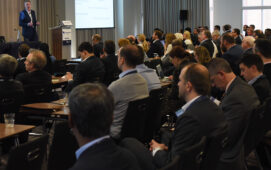In our ongoing exploration of how to inject intelligence into today’s super-fast, highly regulated and highly competitive markets, we like to pick the brains of practitioners who’ve been at the forefront of innovation in this narrow space. With our Intelligent Trading Summit in London just a few months away – February 2, to be precise – we thought it would be useful to catch up with Henri Waelbroeck, director of research at trading platform provider Portware, on the company’s journey from its early trading applications of machine learning and AI, to what might be called an Intelligent EMS.
Henri is a bit of a rocket scientist. Before taking on his current role, he was a professor at the Institute of Nuclear Sciences at the National University of Mexico. Now, he’s charged with leading Portware’s research and development activities.
According to Waelbroeck, machine learning and artificial intelligence in trading has been around for 20 years or so. In trade execution, one of the first applications of these techniques was the concept of algo switching. Traditional algorithms slice institutional trades that are too large to be executed in a block into child orders. Execution performance will depend on the type of algorithm used, which will depend on market conditions, so algo switching picks the best suited algorithm at each point in time.
Traditional algorithmic trading typically offers a level of predictability of outcome over a few minutes. Algo switching allows a machine to oversee the execution process, monitoring market conditions, algo performance as it happens, and then adding or switching algorithms to optimize the result. This approach – using adaptive algorithms – allows the execution team to adapt to the impact of other market algorithms which themselves are acting based on the behavior of the original trading strategy.
Waelbroeck says algo switching and its ilk has been in operation in one form or another since 2007 or so. The approach is responsible for driving how orders interact with market liquidity, but is limited in terms of predictability timeframe. The short prediction timeframe limits its use to the execution, rather than the portfolio management, process.
Subsequent efforts focused on so-called alpha profiling, which allows practitioners to apply algorithms over a longer timescale; this opens the door to applications in portfolio management as well as more strategic decisions in best execution.
According to Waelbroeck, some orders are best handled quickly while others may be better suited for a program of trades over hours, days or even weeks. Portfolio managers need to understand when to execute rapidly and when to take longer, and when to speed up or slow down the overall execution program.
As such, alpha profiling aims to address scheduling-type questions, Waelbroeck says. This approach can assess portfolio managers’ behaviours with respect to trading style (competing for the same shares or taking a contrarian view to the market’s), activity in dark pools and other criteria. Waelbroeck says Portware’s research indicates that a major indicator of future behaviour is a portfolio manager’s own history vis-à-vis other portfolio managers, and alpha profiling can be used to save basis points in terms of execution cost.
Alpha profiling has been de rigueur for the past four or five years, Waelbroeck says, and has been finessed to analyse the impact of trades on market data in order to remove market impact from the alpha profiling model.
Both algo switching and alpha profiling were developed as standalone models. “What’s occurred to us since,” says Waelbroeck, “is that once you introduce predictive models, often one of them discovers something that could be useful to other models.” To harness this potential, he says, Portware initially attempted to engineer a way of combining approaches, but then decided that it needed to happen at the design level. Portware has now adopted a machine learning model approach that allows one model to use the output of another as an input.
The result – a kind of Intelligent EMS – is “a full AI system that predicts and allows agents to collaborate with each other. New models can be added via configuration, with no coding required,” says Waelbroeck.
The solution is currently in beta and is expected to be launched by the end of the year. It allows users to add their own models and strategies in a very rich quantitative environment rather than build every model from the ground up, which Waelbroeck says would be a “nightmare” for clients to do on their own.
The system is aimed at the institutional trading desk of asset management firms, and once deployed can be used by portfolio managers to assist in alpha identification and risk management, he says. This push toward the buy side has been aided, Waelbroeck says, by the strength of institutional analytical offerings from Portware’s parent, FactSet Data Systems.
Waelbroeck says the system can aid with firms’ performance measurement obligations under MiFID II. Standard benchmarks like VWAP or other execution quality measures are no longer suitable, because they encourage behavioral trading practices that are good for benchmark-relative performance metrics rather than for the portfolio. Portware has used a portfolio-based approach to derive a new Transaction Cost Analysis (TCA) framework that measures the role of execution in portfolio performance, and expects to release this capability in the coming year or so.
In each case, the overall purpose is to align practices between portfolio managers and the trading desk by providing a common performance measurement framework that’s suitable for both.
Subscribe to our newsletter




